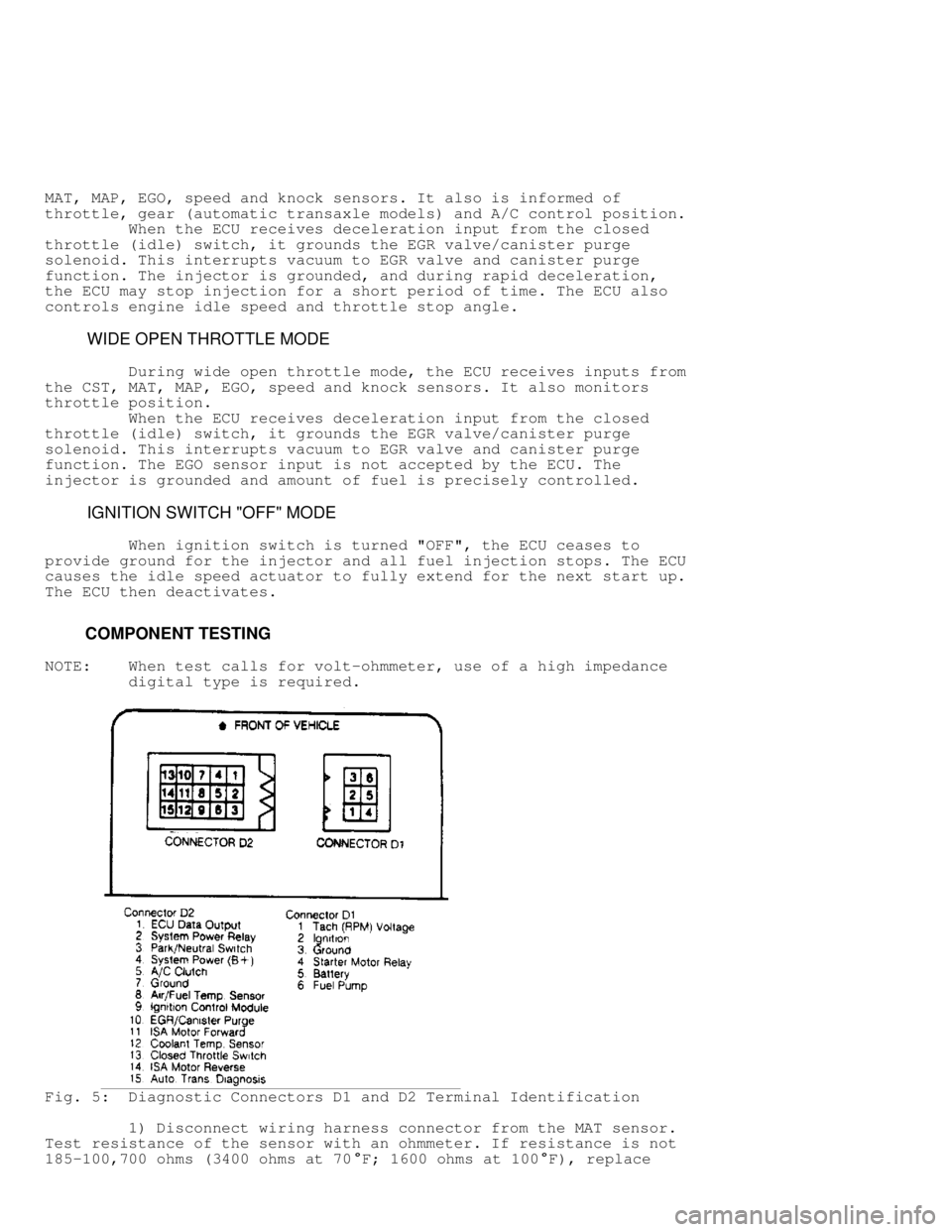1988 JEEP CHEROKEE stop start
[x] Cancel search: stop startPage 20 of 1378

with manifold pressure information.
Knock Sensor
The knock (detonation) sensor, located in the cylinder head,
provides an input signal to the ECU whenever detonation occurs. The
ECU then retards ignition advance to eliminate the detonation at the
applicable cylinders.
Speed Sensor
The speed sensor (or crankshaft position sensor) is mounted
at the flywheel/drive plate housing. The sensor detects the flywheel/
drive plate teeth as they pass during engine operation and sends an
electrical signal to the ECU, which calculates engine speed.
The flywheel/drive plate has a large trigger tooth and notch
located 90
� and 12 small teeth before each top dead center (TDC)
position. When a small tooth or notch pass the magnetic core in the
sensor, the build-up and collapse of the magnetic field induces a
small voltage signal in the sensor pick-up windings.
The ECU counts these signals representing the number of teeth
as they pass the sensor. When a larger trigger tooth and notch pass
the magnetic core, a higher voltage signal is sent to the ECU. This
indicates to the ECU that a piston will be at the TDC position 12
teeth later. The ECU either advances or retards ignition timing as
necessary according to sensor inputs.
Battery Voltage
Battery voltage input to the ECU ensures that proper voltage
is applied to the injector. The ECU varies voltage to compensate for
battery voltage fluctuations.
Starter Motor Relay
The engine starter motor relay provides an input to the ECU,
indicating the starter motor is engaged.
Wide Open Throttle (WOT) Switch
The WOT switch is mounted on the side of the throttle body.
The switch provides a voltage signal to the ECU under wide open
throttle conditions. The ECU responds to this signal by enriching the
air/fuel mixture delivered to the injector.
Closed Throttle (Idle) Switch
This switch is integral with the idle speed actuator (ISA)
motor. The switch provides a voltage signal to the ECU, which
increases or decreases the throttle stop angle in response to engine
operating conditions.
Transmission Gear Position Indicator
The gear position indicator is mounted on vehicles equipped
with automatic transaxles. It provides a signal to the ECU to
indicate that the transaxle is in a driving mode and not in Park or
Neutral.
Power Steering Pressure Switch
The switch increases the idle speed during periods of high
power steering pump load and low engine RPM.
A/C Switch
The A/C switch sends a signal to the ECU when the air
conditioner is operating and when the compressor clutch must be
engaged to lower the temperature. The ECU, in turn, increases engine
speed to compensate for the added load of the air conditioner.
FUEL CONTROL
Page 23 of 1378

input sensors. During engine start-up, the injector delivers an extra
amount of fuel to aid in starting.
EMISSION CONTROL
Both EGR and canister purge operation are regulated by the
ECU. Regulation of these 2 systems is accomplished through the use of
an electrically-operated vacuum solenoid.
Whenever the solenoid is energized by the ECU, it prevents
vacuum action on the EGR valve and canister. The solenoid is
energized by the ECU during engine warm-up, improving cold
driveability. It is also energized during closed throttle (idle),
wide open throttle and during rapid acceleration or deceleration.
In this way the EGR is prevented from operating until the
engine reaches a predetermined temperature. The canister purge does
not operate until the oxygen sensor warms up and becomes operational.
This prevents an over-rich mixture until the oxygen sensor can
compensate for the extra fuel vapor.
IDLE SPEED ACTUATOR (ISA)
The ISA motor, located on the throttle body, is an
electrically-driven actuator that changes the throttle stop angle by
acting as a movable idle stop. The ECU commands the ISA to control
engine idle speed and maintain a smooth idle during sudden engine
deceleration. It does this by providing the appropriate voltage
outputs to produce the idle speed or throttle stop angle required for
the particular engine operating condition. There is no idle speed
adjustment.
For cold engine starting, the throttle is held open for a
longer period to provide adequate engine warm-up prior to normal
operation. When starting a hot engine, the throttle is open for
shorter time.
Under normal engine operating conditions, engine idle is
maintained at a pre-programmed RPM, which may vary slightly due to
engine operating conditions. Under certain engine deceleration
conditions, the throttle is held slightly open.
IGNITION ADVANCE CONTROL
Under certain engine operating conditions, the predetermined
ignition advance curve is modified. This is accomplished through 2
switching circuits that connect the ECU and the ignition control
module.
ECU-CONTROLLED RELAYS
System Power Relay
Located on the right strut tower, this relay is energized
during engine start up and remains energized until 3 to 5 seconds
after the engine is stopped. This permits the ECU to extend the idle
speed actuator for the next start up and then cease operation. See
Fig. 4.
Page 25 of 1378

The ECU controls the A/C compressor clutch by means of the
A/C clutch relay. See Fig. 15.
UP-SHIFT INDICATOR LAMP
Manual transaxle vehicles are equipped with an up-shift
indicator lamp. The lamp is normally turned on when the ignition
switch is turned "ON", and is turned off when the engine starts.
The lamp will again light during engine operation, according
to engine speed and load conditions. A switch, located on the
transaxle, prevents lamp from lighting when transmission is shifted
to the next highest gear. If the shift of gears is not performed, the
ECU will turn the lamp off after 3-5 seconds.
MODES OF OPERATION
IGNITION SWITCH "ON" MODE
When the TBI system is activated by the ignition switch, the
system power relay is energized, and the fuel pump is energized by
the ECU through the fuel pump relay. The pump will operate for
approximately 1 second, unless the engine is operating or the starter
motor is engaged.
The ECU receives input from the CTS, MAT, and MAP sensors.
The up-shift indicator lamp is illuminated.
ENGINE START-UP MODE
When the starter motor is engaged, the ECU receives inputs
from the CTS and speed sensors, the starter motor relay, and the wide
open throttle switch. The fuel pump is activated by the ECU and
voltage is applied to the injector, with the ECU controlling
injection time.
The ECU determines proper ignition timing from the speed
sensor input. If the wide open throttle switch is engaged, the ECU
will deactivate the injector to prevent flooding.
ENGINE WARM-UP MODE
The ECU receives inputs from the CTS, MAT, MAP, speed, and
knock sensors. It also is informed of throttle, gear (automatic
transaxle models) and A/C control position.
The ECU provides a ground for the injector, precisely
controlling fuel delivery to the engine. The ECU also controls
ignition timing, engine idle speed and throttle stop angle. On
vehicles with manual transmissions, the up-shift indicator lamp is
controlled according to engine speed and load.
CRUISE MODE
During cruising speed, the ECU receives inputs from the CTS,
MAT, MAP, EGO, speed and knock sensors. It is also informed of
throttle, gear (automatic transaxle models), and A/C control position.\
The ECU provides a ground to the injector, precisely
controlling injector time. It also controls idle speed, throttle stop
angle, ignition timing, air/fuel mixture ratio and up-shift indicator
lamp.
DECELERATION MODE
During deceleration, the ECU receives inputs from the CTS,
Page 26 of 1378

MAT, MAP, EGO, speed and knock sensors. It also is informed of
throttle, gear (automatic transaxle models) and A/C control position.
When the ECU receives deceleration input from the closed
throttle (idle) switch, it grounds the EGR valve/canister purge
solenoid. This interrupts vacuum to EGR valve and canister purge
function. The injector is grounded, and during rapid deceleration,
the ECU may stop injection for a short period of time. The ECU also
controls engine idle speed and throttle stop angle.
WIDE OPEN THROTTLE MODE
During wide open throttle mode, the ECU receives inputs from
the CST, MAT, MAP, EGO, speed and knock sensors. It also monitors
throttle position.
When the ECU receives deceleration input from the closed
throttle (idle) switch, it grounds the EGR valve/canister purge
solenoid. This interrupts vacuum to EGR valve and canister purge
function. The EGO sensor input is not accepted by the ECU. The
injector is grounded and amount of fuel is precisely controlled.
IGNITION SWITCH "OFF" MODE
When ignition switch is turned "OFF", the ECU ceases to
provide ground for the injector and all fuel injection stops. The ECU
causes the idle speed actuator to fully extend for the next start up.
The ECU then deactivates.
COMPONENT TESTING
NOTE: When test calls for volt-ohmmeter, use of a high impedance
digital type is required.
Fig. 5: Diagnostic Connectors D1 and D2 Terminal Identification
1) Disconnect wiring harness connector from the MAT sensor.
Test resistance of the sensor with an ohmmeter. If resistance is not
185-100,700 ohms (3400 ohms at 70
�F; 1600 ohms at 100�F), replace
Page 51 of 1378

nuts. Install motor and WOT switch bracket assembly on throttle body.
2) Connect wiring harness connector to ISA motor and WOT
switch. Connect the throttle return spring, throttle cable and cruise
control cable. Adjust ISA motor and WOT switch. Install air cleaner
assembly.
NOTE: After replacing or reinstalling the original ISA motor, be
sure motor plunger is fully extended before starting the
engine. If plunger is not fully extended, the closed
throttle switch may open prematurely, causing idle speed to
drop to approximately 400 RPM.
3) Start engine with throttle at 1/4 open position. This
prevents ISA plunger from retracting. Stop engine. When ignition is
turned off, the motor plunger will fully extend. After installation
is complete, adjust ISA as required.
ELECTRONIC CONTROL UNIT
Removal & Installation
Locate ECU in passenger compartment, below glove box. Remove
retaining screws and mounting bracket. Remove the ECU, and disconnect
wiring harness connector from ECU. Reverse removal procedure to
install.
OXYGEN SENSOR
Removal
Disconnect the wire connector from sensor, and unscrew
sensor from exhaust pipe adapter. Clean adapter threads.
Installation
1) Apply anti-seize compound to sensor threads. Do not allow
compound to adhere to any other part of sensor. Hand start the sensor
into place and tighten. Check that wire terminal ends are properly
seated in connector. Connect wire.
2) Do not push the rubber boot over sensor body lower than
1/2" (13 mm) above base of sensor. If the sensor wire should break,
sensor must be replaced. These wires cannot be spliced or otherwise
repaired.
MANIFOLD AIR TEMPERATURE & MANIFOLD ABSOLUTE PRESSURE SENSORS
Removal & Installation
Disconnect wiring harness connector from sensor. Disconnect
vacuum hose from MAP sensor. Remove sensor. Clean MAT sensor manifold
threads, and wrap with Teflon tape. To install, reverse removal
procedure.
COOLANT TEMPERATURE SENSOR (CTS)
Removal & Installation
Allow engine to cool and release pressure from cooling
system. Remove wiring harness from sensor. Remove sensor at rear of
intake manifold, and plug hole to prevent excessive coolant loss. To
install, reverse removal procedure and replace lost coolant.
EGR VALVE & CANISTER PURGE SOLENOID
Removal & Installation
Disconnect wiring harness and vacuum hose from solenoid.
Remove solenoid and bracket as an assembly. Replace solenoid as an
Page 76 of 1378

These small voltage spikes give the ECU information for calculating
engine speed.
When a large tooth and notch pass the magnetic core of the
sensor, the concentration and collapse of the magnetic field created
induces a higher voltage spike into the sensor pick-up coil windings.
This higher voltage spike indicates to the ECU that a piston will soon
be at TDC (12 teeth later).
The ECU uses speed sensor information for advancing or
retarding ignition timing, dependent upon input from other sensors and
switches.
A/C "ON" Switch
This switch signals the ECU that the A/C system is energized.
This signal is used by the ECU to increase idle speed.
Starter Motor Relay
Although no switch or sensor is used, the ECU requires this
information for fuel enrichment during starting. This information is
passed on the the ECU through the starter motor relay.
Distributor Reference Signal
Although no switch or sensor is used, the ECU requires this
information for ignition timing and fuel supply. This information is
relayed to the ECU through a "synch pulse" provided by the distributor
stator. This allows the ECU to synchronize injector opening with
intake valve opening.
ELECTRONIC CONTROL MODULE (ECM)
The Electronic Control Unit (ECU) is the "brain" of the
engine control system. The ECU is located in the passenger
compartment, under left side of dash to right of steering column.
The ECU senses engine operating conditions, processes input
signals, and controls the various systems that affect vehicle
performance.
DIAGNOSTICS
The engine control system has diagnostic capabilities. Using
System Tester (M.S. 1700), diagnostics can be performed on the system
to more accurately determine faulty components. The diagnostic
connectors are located in the engine compartment at the right shock
tower (or under left side of instrument panel).
NOTE: Information for diagnosing the engine control system using
the System Tester (M.S. 1700) was not available from
manufacturer. Only component testing is provided.
ELECTRONIC SPARK ADVANCE
Based upon engine operating conditions received from the
sensors and switches, the ECU controls spark timing. The ECU triggers
the ignition coil through the ignition control module.
IDLE SPEED CONTROL
Idle speed is controlled by the ECU through the idle speed
stepper motor. A latch relay is used to program the stepper motor for
engine start-up. The relay is located on the right inner fender panel.
See Fig. 1 . The ECU energizes the latch relay when engine is in
cranking mode, and keeps the relay energized for 3-5 seconds after the
engine is stopped. In this way, the stepper motor can provide the
Page 82 of 1378

If no continuity is shown, repair wiring harness. If
continuity is shown, reconnect voltmeter as in step 2).
5) While observing voltmeter, crank engine. Voltmeter needle
should fluctuate back and forth during engine cranking. This verifies
proper operation of distributor stator. If voltmeter needle does not
fluctuate, replace stator.
EGR Solenoid Valve
1) Make sure vacuum is present at port "C" of the solenoid.
See Fig. 6 . Remove vacuum connector from ports "A" and "B" of
solenoid. Connect vacuum gauge to port "B". Start engine and run at
idle. Vacuum should not be present at port "B".
2) Disconnect electrical connector from solenoid. Vacuum
should now be present at port "B". Stop engine. Reconnect electrical
connector at solenoid. Remove vacuum gauge and reconnect vacuum hoses.
Relays - General Testing
1) The relays used on the 4.0L engine are all of the same
basic construction and design. Terminal No. 30 is usually connected to
battery voltage ("switched" or battery positive at all times).
Terminal No. 87A is connected to terminal No. 30 in de-energized
position.
2) Terminal No. 87 is connected to terminal No. 30 in the
energized position. This connection supplies battery voltage to the
operated device.
3) Terminal No. 86 is connected to the electromagnet of the
operated device; usually through a "switched" power source. Terminal
No. 85 is connected to the electromagnet of the operated device;
usually grounded through a switch or the ECU.
NOTE: Not all relays have battery voltage applied at terminal No.
30. Some may have battery voltage applied at terminal Nos. 87
or 87A. Check design of relay before testing.
4) When testing relays, there should be continuity between
terminal Nos. 87A and 30 when relay is in de-energized position.
Resistance between terminal Nos. 85 and 86 should be 70-80 ohms for
resistor-type relays and 81-91 ohms for diode-type relays.
Fig. 6: Testing EGR Solenoid Valve
Starter Motor Relay
1) Disconnect electrical connectors from terminals "I" and
"G". Using an ohmmeter, measure resistance between the terminals.
Page 163 of 1378

CAN TAP INSTALLATION
FLAT TYPE SEAL CANS
On cam-lock or one-piece can taps, first turn the handle out
to the fully open position. Securely engage the locking lugs over the
flange of the can, and lock them in place by turning the cam lock or
locking nut. Screw the tap assembly into the adapter so the sealing
gasket is fully seated against the can top. Turn the tap inward to
pierce the can and close the tap. DO NOT open the tap until ready to
purge the service hose or dispense refrigerant into the system.
On 2-piece can taps, be certain the tap handle is turned
fully in, so it is closed. Check that the locking base is turned to
its outer limit. Securely engage the locking lugs over the can
flange. Turn the entire tap assembly (without disturbing the closed
setting) down into the locking base to pierce the can. Do not open
the tap until ready to dispense into system.
SCREW TYPE SEAL CANS
Ensure can tap is fully closed. Screw refrigerant can into
can tap fitting until tight. This will pierce the can. Connect tap to
center hose on manifold gauge set. DO NOT open tap until ready to
dispense R-12 into system.
WARNING: DO NOT open high side hand valve while air conditioning
system is in operation. This high pressure could rupture
can or possibly burst fitting at safety can valve,
resulting in damage and physical injury.
COMPRESSOR OIL CHECK
GENERAL PROCEDURES
Some models have compressor-mounted service valves that allow
oil checking by isolating the compressor. On all others, system must
be discharged, using approved refrigerant recovery/recycling
equipment, and compressor may need to be removed to check oil. After
oil level is checked and adjusted, A/C system must be evacuated and
recharged.
ISOLATING COMPRESSOR
1) Connect manifold gauge set to service valves on the
compressor. Close both gauge valves. Open both service valves to
themid-position.
2) Start engine and operate air conditioning. Turn suction
service valve slowly clockwise toward front-seated position. When
suction pressure is reduced to zero or less, stop engine and quickly
close suction service valve (front-seated).
3) Front-seat the discharge valve. Loosen oil check plug
slowly to release any internal pressure. Service valves can now be
removed from compressor and compressor removed from vehicle (if
necessary). Purge compressor after servicing.
PURGING COMPRESSOR
1) Remove gauge set and place caps on service valve ports.
Back-seat the suction service valve to allow refrigerant to enter
compressor.